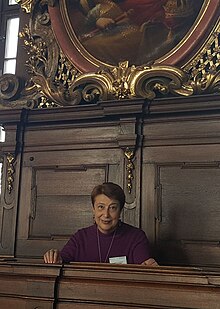Elizaveta Kotorova
Elizaveta Kotorova ( Russian Елизавета Георгиевна Которова * 21st August 1954 in Tomsk ) is a Russian and Polish linguist , German studies , a specialist in the field of general and comparative linguistics , the lexical semantics , the lexicology , the lexicography , the Pragmalinguistics and the ketischen Language .
Life
Kotorova taught at the Faculty of Foreign Languages of the Tomsk State Pedagogical University, as well as at the Tomsk Polytechnic University and Tomsk State University . Since 2005, Kotorova has headed the Chair for Lexicology and Pragmalinguistics at the Institute for German Studies at the University of Zielona Góra .
She completed work and research stays at the Free University of Berlin , the Humboldt University of Berlin (Germany), the University of Udine (Italy), at the Max Planck Institute for Evolutionary Anthropology (Leipzig, Germany), and in the USA at the University of California , Santa Barbara and Columbia University in the City of New York.
She was a scholarship holder of the Alexander von Humboldt Foundation , the German Academic Exchange Service , the Soros Foundation and others
research
Kotorova is the author of more than 150 scientific articles and monographs. The main directions of her scientific activity include:
- Investigation of the problem of inter-lingual equivalence
- Comparative analysis of the lexical-semantic systems of the German, Russian and English languages
- Investigation of the pragmalinguistic peculiarities of language behavior patterns in the German, Russian and Polish languages
- Typological and lexicographical description of the Ketan language , one of the languages of the indigenous people of Siberia
She proposed a new definition of the concept of interlingual equivalence, according to which the equivalence when comparing systems of two languages is determined not between individual lexemes, but between the lexeme of the source language and the corresponding lexical field of another language.
She is currently developing the theory of the “communicative-pragmatic field”, which serves as the basis for describing the forms of realization of various linguistic behavior patterns.
literature
- Złota Księga Nauk Humanistycznych, Gliwice: Wydawnictwo Helion SA - Polski Instytut Biograficzny, 2013.
Web links
Individual evidence
- ↑ И.С. Улуханов. Рецензия. Вопросы языкознания, 1999, N ° 6, с. 135-138. ( Memento of the original from April 4, 2016 in the Internet Archive ) Info: The archive link was inserted automatically and has not yet been checked. Please check the original and archive link according to the instructions and then remove this notice.
- ↑ Bela Brogyanyi. Review. Germanistik, Vol. 42, H. 3/4, 2001, pp. 417-418.
- ↑ Communicative-pragmatic field as a model of culture-related speech behavior. In: Linguistica et res cotidianae (= Linguistic Meeting in Wrocław, vol. 2), ed. by Iwona Bartoszewicz / Joanna Szczęk / Artur Tworek, Wrocław / Dresden (ATUT / Neisse Verlag), 2008, pp. 113–120.
- ^ Describing cross-cultural speech behavior: a communicative-pragmatic field approach. In: Procedia. Social and Behavioral Sciences. Vol. 154, 2014, p. 184-192.
| personal data | |
|---|---|
| SURNAME | Kotorova, Elizaveta |
| ALTERNATIVE NAMES | Которова, Елизавета Георгиевна (Russian) |
| BRIEF DESCRIPTION | Russian linguist |
| DATE OF BIRTH | August 21, 1954 |
| PLACE OF BIRTH | Tomsk |
